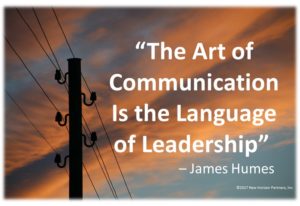
Leadership is influence and influence can only be achieved with good communications. Whether we are promoting a shared vision, encouraging team collaboration, developing our people, or any other part of the leadership role, communication is a key element that determines success as a leader.
Leadership is composed of character and competency. Since good communication is so fundamental to leadership it should be no surprise that there is also both a character and a competency component to good communications.
The best leaders have a drive to communicate, the character element. Because these leaders have a respect for people and a desire to build relationships, the desire to communicate is a part of who they are, a part of their character. These leaders have a desire to know and be known by the people with whom they interact. Communication ties in with the character traits of transparency, humility, openness, empathy and other key traits of leaders.
This desire to communicate should not be confused with the personality factors of introversion and extroversion. Extroverts gain energy through interaction with others while introverts use energy to interact. But the desire to know others and to communicate is a separate trait.
The other part of a leader’s communication is the competency or skill developed to do so most effectively. Great leaders are great communicators. They work hard at learning to communicate effectively. Some of the essential elements of communication competency are clarity, candor, consistency, congruency, and connection.
Clarity – leaders must communicate clearly at a level that is easily understood by the audience.
- Be proactive; people left in the dark wander from the vision and waste energy speculating.
- Understand the purpose of every communication, define the objective, and tailor the means and content to meet the objective.
- Make it simple and concise, understandable to the audience, and focused on the objective; communicate specifics not ambiguities.
- It’s not just the “what” but also the “how” of communicating – appropriate to the purpose, with authority.
Candor – leaders need to be trusted in order to be followed.
- Speak the truth; honesty and transparency builds trust.
- Be open and authentic; communicate from the heart.
- Admit mistakes; people don’t relate to those pretending to be perfect, they relate to those that are human and humble.
- Be willing to embrace the negative, both to admit it and to hear it.
Consistency – maintain a continual flow of information to stay connected.
- Develop and implement a communication plan that schedules periodic communication, both written and verbal, to institutionalize communications.
- Make a point of communicating both with the larger audience and on an individual basis with people throughout the organization.
- Another part of consistency is making the message continually reflect the culture.
Congruency – communication is more than just the words that you write or speak.
- In speaking, both to individuals as well as to a group, be sure that your body language reflects the message that you are seeking to deliver.
- In written and oral communications, check the tone as well as the words you use.
Connection – communication is more than speaking and writing, leaders need to know and relate to their audience.
- Communication is not just distributing information, it includes listening to understand and perceiving emotions and attitudes.
- In individual communication, read body language.
- Speak to the concerns of the listener, know the context.
- Promote two-way communication, solicit feedback.
Your leadership success is dependent upon your communication character and competency.
What are doing to build your communication capability? What are the stumbling blocks to great communications?

Add your comment